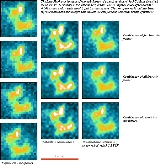
Lucy-Hook coaddition method
Encyclopedia

The Lucy–Hook coaddition method is an image processing technique for combining sub-stepped astronomical image data onto a finer grid. The method allows the option of resolution and contrast enhancement or the choice of a conservative, re-convolved, output.
Tests with very deep Hubble Space Telescope
Hubble Space Telescope
The Hubble Space Telescope is a space telescope that was carried into orbit by a Space Shuttle in 1990 and remains in operation. A 2.4 meter aperture telescope in low Earth orbit, Hubble's four main instruments observe in the near ultraviolet, visible, and near infrared...
Wide Field and Planetary Camera 2
Wide Field and Planetary Camera 2
The Wide Field and Planetary Camera 2 is a baby grand piano sized camera built by the Jet Propulsion Laboratory and formerly installed on the Hubble Space Telescope. It was installed by servicing mission 1 in 1993, replacing the telescope's original Wide Field and Planetary Camera...
(WFPC2) imaging data of excellent quality show that these methods can be very effective and allow fine scale features to be studied better than on the unprocessed images. The Lucy–Hook coaddition method is an extension of the standard Richardson–Lucy deconvolution iterative restoration method.
For many purposes it may be more convenient to combine dithered datasets using the Drizzle (image processing)
Drizzle (image processing)
Drizzle is a digital image processing method for the linear reconstruction of undersampled images. It is normally used for the combination of astronomical images and was originally developed for the Hubble Deep Field observations made by the Hubble Space Telescope...
method.

